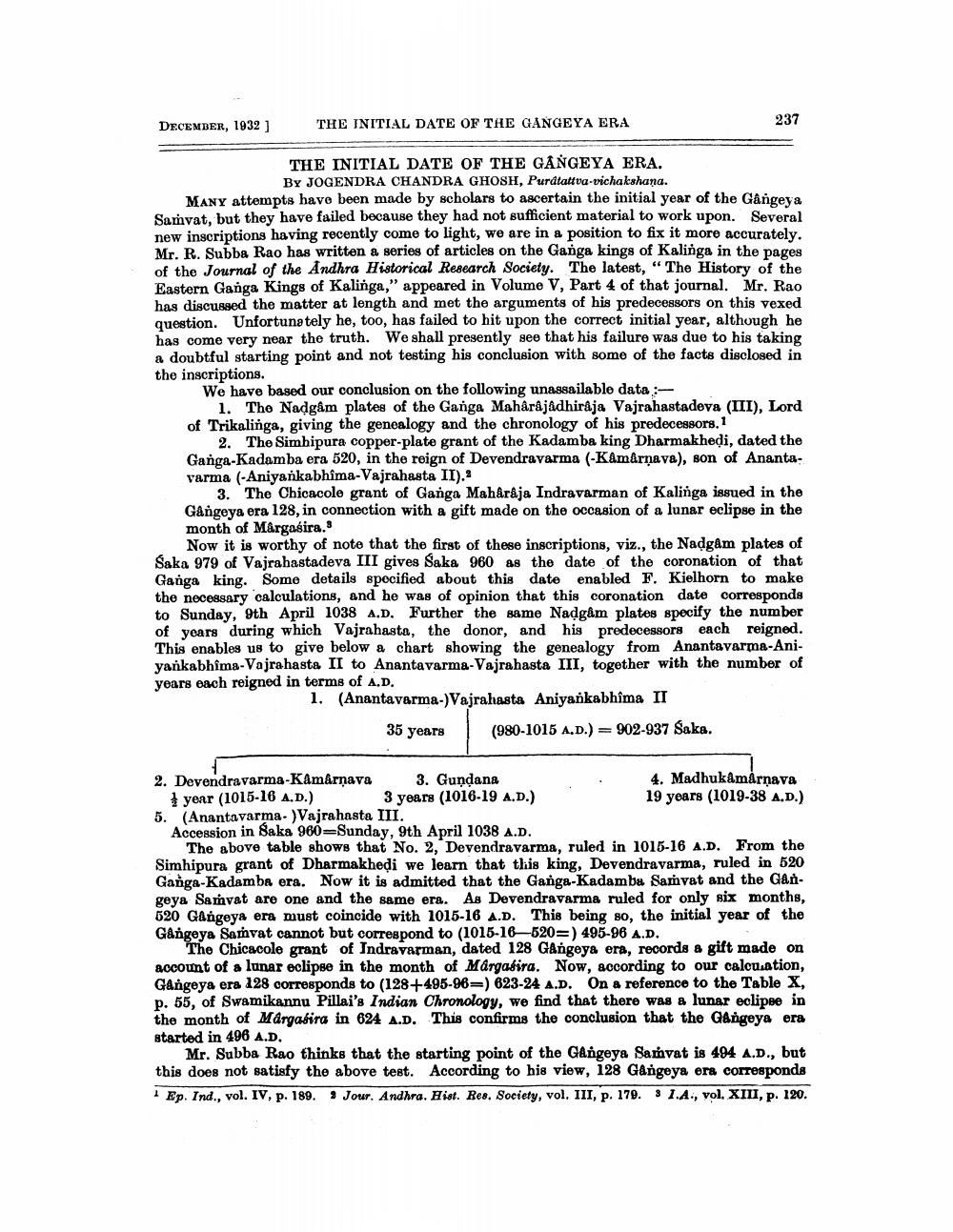________________
DECEMBER, 1932]
THE INITIAL DATE OF THE GANGEYA ERA
THE INITIAL DATE OF THE GANGEYA ERA. BY JOGENDRA CHANDRA GHOSH, Puratattva vichakshana.
MANY attempts have been made by scholars to ascertain the initial year of the Gângeya Samvat, but they have failed because they had not sufficient material to work upon. Several new inscriptions having recently come to light, we are in a position to fix it more accurately. Mr. R. Subba Rao has written a series of articles on the Ganga kings of Kalinga in the pages of the Journal of the Andhra Historical Research Society. The latest, "The History of the Eastern Ganga Kings of Kalinga," appeared in Volume V, Part 4 of that journal. Mr. Rao has discussed the matter at length and met the arguments of his predecessors on this vexed question. Unfortunately he, too, has failed to hit upon the correct initial year, although he has come very near the truth. We shall presently see that his failure was due to his taking a doubtful starting point and not testing his conclusion with some of the facts disclosed in the inscriptions.
237
We have based our conclusion on the following unassailable data :
1. The Naḍgâm plates of the Ganga Mahârâjadhiraja Vajrahastadeva (III), Lord of Trikalinga, giving the genealogy and the chronology of his predecessors. 1
2. The Simhipura copper-plate grant of the Kadamba king Dharmakhedi, dated the Ganga-Kadamba era 520, in the reign of Devendravarma (-Kâmârnava), son of Anantavarma (-Aniyankabhima-Vajrahasta II)."
3. The Chicacole grant of Ganga Mahârâja Indravarman of Kalinga issued in the Gångeya era 128, in connection with a gift made on the occasion of a lunar eclipse in the month of Margasira.
Now it is worthy of note that the first of these inscriptions, viz., the Naḍgâm plates of Saka 979 of Vajrahastadeva III gives Saka 960 as the date of the coronation of that Ganga king. Some details specified about this date enabled F. Kielhorn to make the necessary calculations, and he was of opinion that this coronation date corresponds to Sunday, 9th April 1038 A.D. Further the same Nadgâm plates specify the number of years during which Vajrahasta, the donor, and his predecessors each reigned. This enables us to give below a chart showing the genealogy from Anantavarma-Aniyankabhima-Vajrahasta II to Anantavarma-Vajrahasta III, together with the number of years each reigned in terms of A.D.
1. (Anantavarma-)Vajrahasta Aniyankabhîma II
35 years
(980-1015 A.D.) 902-937 Saka.
=
4. Madhukamarṇava 19 years (1019-38 A.D.)
3. Gundana
2. Devendravarma-Kâmârnava year (1015-16 A.D.)
3 years (1016-19 A.D.)
5. (Anantavarma- )Vajrahasta III. Accession in Saka 960-Sunday, 9th April 1038 A.D.
The above table shows that No. 2, Devendravarma, ruled in 1015-16 A.D. From the Simhipura grant of Dharmakhedi we learn that this king, Devendravarma, ruled in 520 Ganga-Kadamba era. Now it is admitted that the Ganga-Kadamba Samvat and the Gângeya Samvat are one and the same era. As Devendravarma ruled for only six months, 520 Gangeya era must coincide with 1015-16 A.D. This being so, the initial year of the Gângeya Samvat cannot but correspond to (1015-16-520-) 495-96 A.D.
The Chicacole grant of Indravarman, dated 128 Gangeya era, records a gift made on account of a lunar eclipse in the month of Margasira. Now, according to our calculation, Gangeya era 128 corresponds to (128+495-96-) 623-24 A.D. On a reference to the Table X, p. 55, of Swamikannu Pillai's Indian Chronology, we find that there was a lunar eclipse in the month of Margasira in 624 A.D. This confirms the conclusion that the Gangeya era started in 496 A.D.
Mr. Subba Rao thinks that the starting point of the Gangeya Samvat is 494 A.D., but this does not satisfy the above test. According to his view, 128 Gângeya era corresponds 1 Ep. Ind., vol. IV, p. 189. Jour. Andhra. Hist. Res. Society, vol. III, p. 179. 3 I.A., vol. XIII, p. 120.




